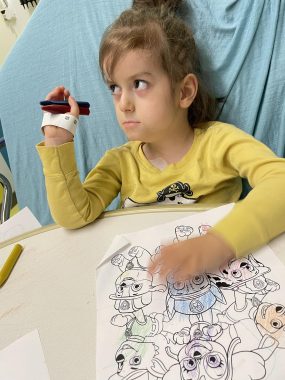Uh-oh, the Port’s Not Working. What’s Next for a Mother and Son?
What happens when a regular enzyme replacement therapy isn't possible

Recently, we had a weird occurrence. For the first time, we had trouble accessing the port of my 4-year-old son, Cayden, for his infusion.
A port is a small device that’s placed under the skin, usually in the chest, for multiple tasks, including blood draws, infusions, transfusions, IV fluids, and medications. In Cayden’s case, he receives biweekly enzyme replacement therapy infusions through his port due to his infantile-onset Pompe disease. He’s been getting these infusions since he was about 4 weeks old, and usually, everything runs smoothly.
That wasn’t the case this time.
When Cayden’s home infusion nurse came to do his treatment, she started to access his port, like always. In fact, she tried four different times to access it. Each time she couldn’t get any blood return from it or push any fluids into it. Cayden was also screaming and crying while the nurse was trying to do this, which isn’t like him. We couldn’t use the port, which isn’t typical at all.
Since the port problem had never happened before, we called both the nurse’s agency and Cayden’s metabolic specialist office, which manages everything infusion-related. Both calls directed us to the emergency room so that hospital staff could check on his port to learn what was wrong. We’d expected this would be the next step.
I immediately packed our things and we went to our local children’s hospital, which is about 40 minutes away. There we spent about three hours in the waiting room before we were taken back to a smaller room. I understood the wait because the hospital was full of sick kids that day, as respiratory syncytial virus and other common colds were spreading like crazy in our area. We’d been in the shoes of the other families whose children were sick. I’d much rather their child get help for something more serious than our port issue, so I didn’t mind waiting for a little.
Eventually, hospital staff started the process of figuring out why Cayden’s port wasn’t working. The first step was an X-ray to ensure that his port was still in the right spot and hadn’t flipped or moved. If there’s an issue, they always want to make sure the port’s in the right spot before attempting to access it.

Cayden colors as we wait for the X-ray results. (Photo by Keara Engle)
However, the X-ray showed that Cayden’s port was indeed in the right spot, so they had to dig a little deeper. The nurses tried to access it, but they were unable to get any blood return or push any fluids through it. The emergency room team then suspected that a blood clot was lodged somewhere in the line of his port. This is relatively common, as blood can get stuck in the port and clot between accesses.
To combat this issue, they pushed as much medication as they could into the port to break up the clot. They had to use a bit of force, but they were successful. Afterward, fluids were able to be pushed in just fine, and blood return could happen. It was a huge relief.
I’d been so nervous that they wouldn’t be able to get Cayden’s port to work. The worst-case scenario was that he’d need surgery to replace it, and I’d begun to think that would happen. However, it was just a blood clot, which is relatively common.
Once they got his port working, we went home. The nurse was able to return a few days later for his infusion, and it wasn’t a problem.
Although this was the first time we’ve had an issue with Cayden’s port, it may not be the last. But for now, I’m just so thankful that everything worked out in the end.
Note: Pompe Disease News is strictly a news and information website about the disease. It does not provide medical advice, diagnosis, or treatment. This content is not intended to be a substitute for professional medical advice, diagnosis, or treatment. Always seek the advice of your physician or other qualified health provider with any questions you may have regarding a medical condition. Never disregard professional medical advice or delay in seeking it because of something you have read on this website. The opinions expressed in this column are not those of Pompe Disease News or its parent company, Bionews, and are intended to spark discussion about issues pertaining to Pompe disease.








Leave a comment
Fill in the required fields to post. Your email address will not be published.